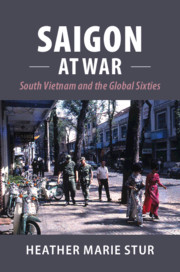Book contents
- Saigon at War
- Cambridge Studies in US Foreign Relations
- Saigon at War
- Copyright page
- Dedication
- Contents
- Figures
- Acknowledgments
- Introduction
- 1 The Heart of South Vietnam
- 2 A Tradition of Activism
- 3 South Vietnam’s Sixties Youth
- 4 South Vietnam and the World
- 5 Building Connections between the People and the Government
- 6 Saigon after Tet
- 7 The Catholic Opposition and Political Repression
- 8 Saigon in the Seventies
- Conclusion
- Select Bibliography
- Index
3 - South Vietnam’s Sixties Youth
Published online by Cambridge University Press: 15 May 2020
- Saigon at War
- Cambridge Studies in US Foreign Relations
- Saigon at War
- Copyright page
- Dedication
- Contents
- Figures
- Acknowledgments
- Introduction
- 1 The Heart of South Vietnam
- 2 A Tradition of Activism
- 3 South Vietnam’s Sixties Youth
- 4 South Vietnam and the World
- 5 Building Connections between the People and the Government
- 6 Saigon after Tet
- 7 The Catholic Opposition and Political Repression
- 8 Saigon in the Seventies
- Conclusion
- Select Bibliography
- Index
Summary
One morning in early November 1965, student leader Nguyen Huu Thai visited US Embassy officer Melvin Levine at his Saigon apartment. Thai was the president of an architecture students’ organization at Saigon University and former Saigon Student Union president, and he hoped to explain to Levine why there had been so much student unrest, not just in Saigon, but in Hue and other cities as well. Thai had made a trip to Hue to try and get a clearer sense of the student perspective there, and what he found was that the war was more real to students in Hue than it was to their peers in Saigon. Hue students were concerned about and frustrated by the large American military presence in Da Nang, and the fighting in the I Corps rural areas felt closer to them than perhaps the fighting in the Mekong Delta felt to Saigon students, Thai explained. Thai wanted to see the rural areas for himself, so he took a car trip through Quang Ngai and Quang Nam, and he talked with peasants who believed that the ongoing artillery fire and air strikes were indiscriminate rather than targeted at known NLF areas. Peasants also felt squeezed by the growing refugee population and accused refugees of harvesting their crops; that American troops often took their farming tools, suspecting that they were weapons, compounded the peasants’ frustrations.1
- Type
- Chapter
- Information
- Saigon at WarSouth Vietnam and the Global Sixties, pp. 77 - 111Publisher: Cambridge University PressPrint publication year: 2020

